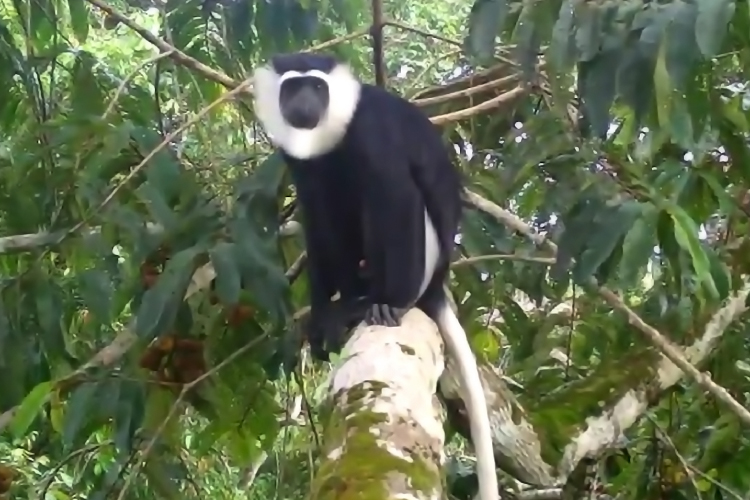7/1/2020
Serious Monkey Business
Search for Lost Monkey Species Takes FAU Research Cameras into Treetops of West Africa
By Lynn Laurenti
High in the trees of the Tanoé-Ehy Forest in West Africa, a team led by Florida Atlantic University and the Swiss Center for Scientific Research in Côte d’Ivoire is capturing rare video images of monkeys on the verge of extinction.
The project began in May of 2019 with the primary aim of finding evidence that Miss Waldron’s red colobus monkey, unseen since 1978, still exists. While that objective has yet to be achieved, the camera traps have caught sight of other rarely seen monkeys, including the first footage ever taken in the wild of the critically endangered roloway monkey.
The monkey at the center of the search was originally discovered in 1933 by Willoughby P. Lowe of the British Museum. He named it after Miss Fanny Waldron, a colleague who accompanied him on the expedition. Although the species was declared extinct in 2000, hope remains alive that some individuals may have survived in the Tanoé-Ehy Forest of Côte d’Ivoire, based on sightings reported by local hunters. One villager was even able to duplicate its distinctive cry. The Tanoé-Ehy Forest has been designated a Key Biodiversity Area by the International Union for the Conservation of Nature. Today, Miss Waldron’s red colobus monkey is on Global Wildlife Conservation’s list of the 25 “most wanted lost species.”
FAU’s involvement in the project traces its origin to the summer of 2018, when Kate Detwiler, Ph.D., associate professor of anthropology in the Charles E. Schmidt College of Science, took students in her research lab to Nairobi to participate in an international conference organized by the African Primatological Society. “One of the symposia was on these monkeys,” Detwiler said. “We made a presentation on the multilevel camera system we have developed in our lab to find elusive monkey species.”
The technique involves the strategic placement of video cameras on the ground, at mid-level and in the forest canopy. That prompted Barney Long, Global Wildlife Conservation’s senior director of species conservation, to invite FAU to join the long-stymied Miss Waldron’s search.
“So far, we’ve been over there three times,” Detwiler said. FAU’s man in the treetops is integrative biological sciences doctoral student Daniel Alempijevic, who built upon tree-climbing experience he gained in a previous collaboration with Detwiler in the rain forest of the Democratic Republic of Congo. The Tanoé-Ehy Forest project has produced more than 20,000 videos yielding images of the white-thighed colobus monkey, white-naped magabey monkey, spot-nosed monkey, roloway monkey, Lowe’s monkey and the olive colobus monkey. Other denizens of the rain forest caught on camera include the long-tailed pangolin, the white-crested hornbill, the piping hornbill, the Congo serpent eagle and the yellow-billed turaco.
“Back here at FAU, we have a team of undergraduate students who earn research credits by going through the video files to find specific animals and gather information on them,” Detwiler said. “We send everything to our partners in Africa, who incorporate the information into their database.” Coordinating the massive data entry process at FAU are Laurie Uddine, a community volunteer, and undergraduate Aaron Mencia.
Does hope live on that Miss Waldron’s red colobus monkey still exists? “I think so,” Detwiler said. “Hunters report that they still see the monkey.”
The two main threats to all animals living in the Tanoé-Ehy Forest are hunting activity and possible development of what is currently swampland. “Preserving this area has become an issue of international importance,” Detwiler said. “The struggle in Côte d’Ivoire, as here in Florida and other parts of the world, is between development and conservation. There are many people in Côte d’Ivoire who are working to protect both the land and its animals.”
If you would like more information, please contact us at dorcommunications@fau.edu.
